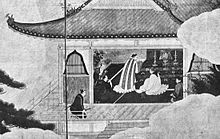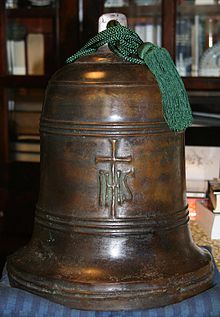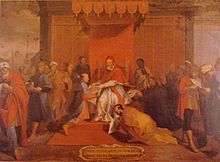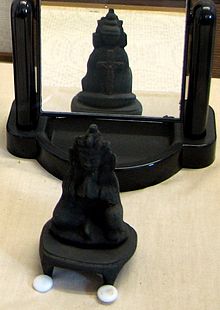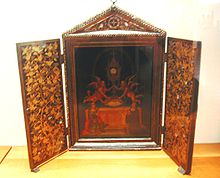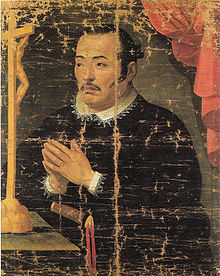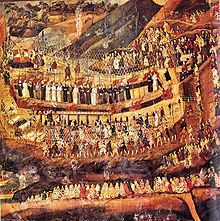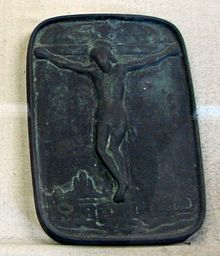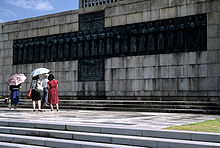- Kirishitan
-
Kirishitan
吉利支丹, 切支丹, キリシタン
Japanese Christians ("Kirishitan") in Portuguese costume, 16-17th century.Founder Jesus Christ Regions with significant populations Japan Religions Christianity Scriptures The Bible Languages Japanese Kirishitan (吉利支丹, 切支丹, キリシタン), from Portuguese cristão, referred to Roman Catholic Christians in Japanese and is used as a historiographic term for Roman Catholics in Japan in the 16th and 17th centuries. Christian missionaries were known as bateren (from the Portuguese word padre, "father")[1] or iruman (from the Portuguese irmão, "brother"). Both the transcriptions 切支丹 and 鬼利死丹 came into use during the Edo Period when Christianity was a forbidden religion. The Kanji used for the transcriptions have negative connotations.
Portuguese ships began arriving in Japan in 1543,[2] with Catholic missionary activities in Japan beginning in earnest around 1549, mainly by Portuguese-sponsored Jesuits until Spanish-sponsored mendicant orders, such as the Franciscans and Dominicans, gained access to Japan. Of the 95 Jesuits who worked in Japan up to 1600, 57 were Portuguese, 20 were Spaniards and 18 Italian.[3] Francis Xavier,[4][5] Cosme de Torres (a Jesuit priest), and Father John Fernandes were the first, who arrived to Kagoshima with hopes to bring Christianity and Catholicism to Japan. At its height, Japan is estimated to have had around 300,000 Christians.[6] Catholicism was subsequently repressed in several parts of the country and ceased to exist publicly in the 17th century.
The line of demarcations between Portugal and Spain
Religion was an integral part of the state and evangelization was seen as having both secular and spiritual benefits for both Portugal and Spain. Wherever these powers attempted to expand their territories or influence, missionaries would soon follow. By the Treaty of Tordesillas, the two powers divided the world between them into exclusive spheres of influence, trade and colonization. Although at the time of the demarcation, neither nation had any direct contact with Japan, that nation fell into the sphere of the Portuguese.
The countries disputed the attribution of Japan. Since neither could colonize it, the exclusive right to propagate Christianity in Japan meant the exclusive right to trade with Japan. Portuguese-sponsored Jesuits under Alessandro Valignano took the lead in proselytizing in Japan over the objection of the Spaniards. The fait accompli was approved in Pope Gregory XIII's papal bull of 1575, which decided that Japan belonged to the Portuguese diocese of Macau. In 1588, the diocese of Funai (Nagasaki) was founded under Portuguese protection.
In rivalry with the Jesuits, Spanish-sponsored mendicant orders entered into Japan via Manila. While criticizing Jesuit activities, they actively lobbied the Pope. Their campaigns resulted in Pope Clement VIII's decree of 1600, which allowed Spanish friars to enter Japan via the Portuguese Indies, and Pope Paul V's decree of 1608, which abolished the restrictions on the route. The Portuguese accused Spanish Jesuits of working for their homeland instead of their patron. The power struggle between Jesuits and mendicant orders caused a schism within the diocese of Funai. Furthermore, mendicant orders tried in vain to establish a diocese on the Tohoku region that was to be independent from the Portuguese one.
The Roman Catholic world order was challenged by the Netherlands and England. Theoretically, it was repudiated by Grotius's Mare Liberum. In the early 17th century, Japan built trade relations with the Netherlands and England. Although England withdrew from the operations in ten years under James I due to lack of profitability, the Netherlands continued to trade with Japan and became the only European country that maintained trade relations with Japan until the 19th century. As trade competitors, the Protestant countries engaged in a negative campaign against Catholicism, and it subsequently affected shogunate policies toward the Iberian kingdoms.
Portugal's and Spain's colonial policies were also challenged by the Roman Catholic Church itself. The Vatican founded the Congregatio de Propaganda Fide in 1622 and attempted to separate the churches from the influence of the Iberian kingdoms. However, it was too late for Japan. The organization failed to establish staging points in Japan.
Propagation strategy
The Jesuits believed that it was better to seek to influence people in power and then allow the religion to be passed downwards to the commoners later.[7] They tried to avoid suspicion by not preaching to the commoners without permission from the local rulers to propagate Catholicism within their domains.[7] As a result, several daimyo became Christians, soon to be followed by many of their subjects as the Dominicans and Augustinians were able to begin preaching to the commoners.[7] After the edict banning Christianity, there were communities that kept practicing Catholicism without having any contact with the Church until missionaries were able to return much later.
When Xavier disembarked in Kagoshima, the principal chiefs of the two branches of the Shimazu family, Sanehisa and Katsuhisa, were warring for the sovereignty of their lands. Katsuhisa, adopted Takahisa Shimazu who in 1542 was accepted as head of the clan having previously received the Portuguese merchants on Tanegashima Island, learning about the use of firearms. Later, he met Xavier himself at the castle of Uchiujijo and permitted the conversion of his vassals.
Having a religious background, Takahisa showed himself to be benevolent and already allowed freedom of worship but not helping the missionaries nor favoring their church. Failing to find a way to the centre of affairs, the court of the Emperor, Xavier soon tired and left to Yamaguchi thus beginning the Yamaguchi period.[8] Xavier, stayed in Yamaguchi for two months on his way to an abortive audience with the Emperor in Kyoto. Yamaguchi was already a prosperous and refined city and its leaders, the Ouchi family, were aware that Xavier's journey to Japan had begun after the completion of his mission in India.
They took Catholicism for some sort of new sect of Buddhism and were curious to know of the priest's doctrine. Tolerant but shrewd, their eyes less on baptism than the Portuguese cargoes from Macao, they granted the Jesuit permission to preach. The uncompromising Xavier took to the streets of the city denouncing, among other things, infanticide, idolatry and homosexuality (the last being widely accepted at the time). Misunderstandings were inevitable.
Christian books were published in Japanese from the 1590s on, some with more than one thousand copies and from 1601 a printing press was established under the supervision of Soin Goto Thomas, a citizen of Nagasaki with thirty Japanese working full time at the press. Liturgical calendars were also printed after 1592 until at least 1634. Christian solidarity made also possible missionary mail delivery throughout the country until the end of the 1620s.
Nature of early Christian community
Different groups of laymen supported Christian life in Japanese mission, e.g.; dōjuku, kanbō and jihiyakusha helped the clergymen in activities like the celebration of Sunday liturgy in the absence of ordained clergy, religious education, preparation of confessions, and spiritual support of the sick. By the end of the 16th century kanbō and jihiyakusha had similar responsibilities and also organized funerals and baptized children with permission to baptize from Rome. The kanbō were those who had left secular life but not taken formal vows, while the jihiyakusha were married and had a profession.
These groups were fundamental to the mission, and themselves depended on both the ecclesiastical hierarchy as well as the warlords who controlled the lands where they lived. Therefore, the success of the Japanese mission cannot be explained only as the result of the action of a brilliant group of missionaries, or of the commercial and political interests of a few daimyo and traders.
At the same time the missionaries faced the hostility of many other daimyo. Christianity challenged Japanese civilization. A militant lay community, the main reason for missionary success in Japan, was also the main reason for the anti-Christian policy of the Tokugawa's bakufu.
Economic activities
The Jesuits in Japan had to maintain economic self-sufficiency because they could not expect stable and sufficient payment from their patron, the King of Portugal, the king allowing the Jesuits to engage in trade with Japan. Such economic activity can be found in the work of Francis Xavier, the pioneer of Catholic missions in Japan, who covered the cost of missionary work through merchant trading. From the 1550s to the 1570s, the Jesuits covered all necessary expenses with trade profits and bought land in India.
Their officially recognized commercial activity was a fixed-amount entry into the Portuguese silk trade between Macau and Nagasaki. They financed to a certain amount the trade association in Macau, which purchased raw silk in Canton and sold it in Nagasaki. They did not confine their commercial activity to the official silk market but expanded into unauthorized markets. For the Macau-Nagasaki trade, they dealt in silk fabrics, gold, musk and other goods including military supplies and slavery. Sometimes, they even got involved in Spanish trade, prohibited by the kings of Spain and Portugal, and antagonized the Portuguese traders.
It was mainly procurators who brokered Portuguese trade. They resided in Macau and Nagasaki, and accepted purchase commitments by Japanese customers such as the shogunate daimyo and wealthy merchants. By brokerage, the Jesuits could expect not only rebates but also favorable treatment from the authorities. For this reason, the office of procurator became an important post amongst the Jesuits in Japan. Although trade activities by the Jesuits ate into Portuguese trade interests, procurators continued their brokerage utilizing the authority of the Catholic Church. At the same time, Portuguese merchants required the assistance of procurators who were familiar with Japanese customs, since they established no permanent trading post in Japan. Probably the most notable procurator was João Rodrigues, who approached Toyotomi Hideyoshi and Tokugawa Ieyasu and even participated in the administration of Nagasaki.
Such commercial activities were contrary to the idea of honorable poverty that the priests held. But some Jesuits at this time placed the expansion of the society's influence before this ideal. Mendicant orders fiercely accused the Jesuits of being corrupt and even considered their activity as the primary reason for Japan's ban on Catholicism. Mendicant orders themselves were not necessarily uninvolved in commercial activities.
Military activities
Missionaries were not reluctant to take military action if they considered it an effective way to Christianize Japan. They often associated military action against Japan with the conquest of China. They thought that well-trained Japanese soldiers who had experienced long civil wars would help their countries conquer China. For example, Alessandro Valignano said to the Philippine Governor that it was impossible to conquer Japan because the Japanese were very brave and always received military training but that Japan would benefit them when they would conquer China. Francisco Cabral also reported to the King of Spain that priests were able to send to China two or three thousand Japanese Christian soldiers who were brave and were expected to serve the king with little pay.
The Jesuits provided various kinds of support including military support to Kirishitan daimyo when they were threatened by non-Kirishitan daimyo. Most notable was their support of Omura Sumitada and Arima Harunobu, who fought against the anti-Catholic Ryuzoji clan. In the 1580s, Valignano believed in the effectiveness of military action and fortified Nagasaki and Mogi. In 1585, Gaspar Coelho asked the Spanish Philippines to send a fleet but the plan was rejected due to the shortness of its military capability. Christians Protasio Arima and Paulo Okamoto were named as principals in an assassination plot to murder the magistrate in charge of the Shogunate's most important port city of Nagasaki.
Early policy toward Catholicism
When the Jesuit priest Francis Xavier arrived, Japan was experiencing a nationwide civil war. Neither the emperor nor the Ashikaga shogun could exercise power over the nation. At first, Xavier planned to gain permission for building a mission from the emperor but was disappointed with the devastation of the imperial residence. The Jesuits approached daimyo in southwestern Japan and succeeded in converting some of these daimyo. One reason for their conversion may have been the Portuguese trade in which the Jesuits acted as brokers. The Jesuits recognized this and approached local rulers with offers of trade and exotic gifts.
The Jesuits attempted to expand their activity to Kyoto and the surrounding regions. In 1559, Gaspar Vilela obtained permission from Ashikaga Yoshiteru to teach Christianity. This license was the same as those given to Buddhist temples, so special treatment cannot be confirmed regarding the Jesuits. On the other hand, Emperor Ogimachi issued edicts to ban Catholicism in 1565 and 1568. The orders of the Emperor and the Shogun made little difference.
Christians refer positively to Oda Nobunaga, who died in the middle of the unification of Japan. He favored the Jesuit missionary Luis Frois and generally tolerated Christianity. But overall, he undertook no remarkable policies toward Catholicism. Actually, Catholic power in his domain was trivial because he did not conquer western Japan, where the Jesuits were based. By 1579, at the height of missionary activity, there were about 130,000 converts.[9]
Toyotomi Hideyoshi and the Christian Daimyo
 Letter from Duarte de Meneses, viceroy of Portuguese India, to daimyo Toyotomi Hideyoshi dated April 1588, concerning the suppression of Christians, a National Treasure of Japan[10][11]
Letter from Duarte de Meneses, viceroy of Portuguese India, to daimyo Toyotomi Hideyoshi dated April 1588, concerning the suppression of Christians, a National Treasure of Japan[10][11]
 The Virgin Mary disguised as Kannon, Kirishitan cult, 17th century Japan. Salle des Martyrs, Paris Foreign Missions Society.
The Virgin Mary disguised as Kannon, Kirishitan cult, 17th century Japan. Salle des Martyrs, Paris Foreign Missions Society.
The situation was changed when Toyotomi Hideyoshi reunified Japan. Once he became the ruler of Japan, Hideyoshi began to pay attention to external threats, particularly the expansion of European power in East Asia. The turning point for Catholic missions was the San Felipe incident, where in an attempt to recover his cargo, the Spanish captain of a shipwrecked trading vessel claimed that the missionaries were there to prepare Japan for conquest. These claims made Hideyoshi suspicious of the foreign religion.[12] He attempted to curb Catholicism while maintaining good trading relations with Portugal and Spain, which might have provided military support to Dom Justo Takayama, a Christian Daimyo in western Japan. Many Daimyos converted to Christianity in order to gain more favorable access to saltpeter, used to make gunpowder. Between 1553 and 1620, eighty-six Daimyos were officially baptized, and many more were sympathetic to the Christians.[13]
By 1587, Hideyoshi had become alarmed, not because of too many converts but rather because the hegemon learned that Christian lords reportedly oversaw forced conversions of retainers and commoners, that they had garrisoned the city of Nagasaki, that they participated in the slave trade of other Japanese and, apparently offending Hideyoshi's Buddhist sentiments, that they allowed the slaughter of horses and oxen for food.[14] After his invasion of Kyushu, Hideyoshi Toyotomi promulgated the Purge Directive Order to the Jesuits (バテレン追放令 bateren tsuihō rei) on July 24, 1587. It consists of 11 articles: "No. 10. Do not sell Japanese people to the Namban (Portuguese)."[citation needed] Among the contents were a ban on missionaries.[1] The Jesuits in Nagasaki considered armed resistance, but the plans did not come to fruition.[1] Led by Coelho, they sought help from Kirishitan daimyo, but the daimyo refused. Then they called for a deployment of reinforcements from their homeland and its colonies, but this plan was abolished by Valignano. Like the Kirishitan daimyo, he realized that a military campaign against Japan's powerful ruler would bring catastrophe to Catholicism in Japan. Valignano survived the crisis by laying all the blame on Coelho, and in 1590, the Jesuits decided to stop intervening in the struggles between the daimyo and to disarm themselves. They only gave secret shipments of food and financial aid to Kirishitan daimyo.
However, the 1587 decree was not particularly enforced.[15] In contrast to the Jesuits, the Dominicans, Franciscans, and Augustinians were openly preaching to the common peoples; this caused Hideyoshi to become concerned that commoners with divided loyalties might lead to dangerous rebels like the Ikkō-ikki sect of earlier years;[16] this led to Hideyoshi putting the 26 Martyrs of Japan followers to death in 1597 on his order.[17] After Hideyoshi died in 1598, amidst the chaos of succession there was less of a focus on persecuting Christians.[18]
Expansion
By the end of the 16th century, the Japanese mission had become the largest overseas Christian community that was not under the rule of a European power. Its uniqueness was emphasized by Alessandro Valignano since 1582, who promoted a deeper accommodation of Japanese culture. Japan was then the sole overseas country in which all members of those confraternities were locals, as was the case with Christian missions in Mexico, Peru, Brazil, the Philippines, or India, in spite of the presence of a colonial elite.
Most Japanese Christians lived in Kyushu, but Christianization was not a regional phenomenon and had a national impact. By the end of the 16th century it was possible to find baptized people in virtually every province of Japan, many of them organized in communities. On the eve of the Sekigahara battle, fifteen daimyo were baptized, and their domains stretched from Hyuga in Southeast Kyushu to Dewa in North Honshū.[19] Hundreds of churches had been built throughout Japan.
Accepted on a national scale, Christianity was also successful among different social groups from the poor to the rich, peasants, traders, sailors, warriors, or courtesans. Most of the daily activities of the Church were done by Japanese from the beginning, giving the Japanese Church a native face, and this was one of the reasons for its success. By 1590, there were seventy native brothers in Japan, fully one half of Jesuits in Japan and fifteen percent of all Jesuits who were working in Asia.
In June 1592, Hideyoshi invaded Korea; among his leading generals was Christian daimyo Konishi Yukinaga.[20] The actions of his forces in the massacre and enslavement of many of the Korean people were indistinguishable from the non-Christian Japanese forces that participated in the invasion.[21] After Hideyoshi's death and Konishi's loss in the battle of Sekigahara, Konishi would base his refusal to commit seppuku on his Christian beliefs; instead of taking his own life, he chose capture and execution.[22]
The 1592 war between Japan and Korea also provided Westerners with a rare opportunity to visit Korea. Under orders of Gomaz, the Jesuit Gregorious de Cespedes arrived in Korea with a Japanese monk for the purposes of administering to the Japanese troops. He stayed there for approximately 18 months, until April or May of 1595, thus being on record as the first European missionary to visit the Korean peninsula but was unable to make any inroads. The 'Annual Letters of Japan' made a substantial contribution to the introduction of Korea to Europe, Francis Xavier having crossed paths with Korean envoys dispatched to Japan during 1550 and 1551.
The Japanese missions were economically self-sufficient. Nagasaki’s misericórdias became rich and powerful institutions which every year received large donations. The brotherhood grew in numbers to over 100 by 1585 and 150 in 1609. Controlled by the elite of Nagasaki, and not by Portuguese, it had two hospitals (one for lepers) and a large church. By 1606, there already existed a feminine religious order called Miyako no Bikuni (nuns of Kyoto) which accept Korean convents such as Marina Pak, baptized in Nagasaki.[19] Nagasaki was called “the Rome of Japan” and most of its inhabitants were Christians. By 1611, it had ten churches and was divided into eight parishes including a specifically Korean order.
Tokugawa response
Following Toyotomi Hideyoshi's death in 1598, Tokugawa Ieyasu assumed power over Japan in 1600. Like Toyotomi Hideyoshi, he disliked Christian activities in Japan but gave priority to trade with Portugal and Spain. He secured Portuguese trade in 1600. He negotiated with Manila to establish trade with the Philippines. The trade promotion made his policies toward Catholicism inconsistent. At the same time, in an attempt to wrest control of the Japan trade from the Catholic countries, Dutch and British traders advised the Shogunate that Spain did indeed have territorial ambitions, and that Catholicism was Spain's principal means. The Dutch and British promised, in distinction, that they would limit themselves to trading and would not conduct missionary activities in Japan.
It seems that the Jesuits realized that the Tokugawa shogunate was much stronger and more stable than Toyotomi Hideyoshi's administration, yet the mendicant orders relatively openly discussed military options. In 1615, a Franciscan emissary of the Viceroy of New Spain asked the shogun for land to build a Spanish fortress and this deepened Japan's suspicion against Catholicism and the Iberian colonial powers behind it. The Jesuits and the Mendicant Orders kept a lasting rivalry over the Japanese mission and attached to different imperial strategies.
The Tokugawa shogunate finally decided to ban Catholicism. In the statement on the "Expulsion of all missionaries from Japan", drafted by Zen monk Konchiin Suden (1563–1633) and issued in 1614 under the name of second shogun Hidetada (ruled 1605-1623), was considered the first official statement of a comprehensive control of Kirishitan.[23] It claimed that the Christians were bringing disorder to Japanese society and that their followers "contravene governmental regulations, traduce Shinto, calumniate the True Law, destroy regulations, and corrupt goodness".[24] It was fully implemented and canonized as one of the fundamental Tokugawan laws. In the same year, the bakufu required all subjects of all domains to register at their local Buddhist temple; this would become an annual requirement in 1666, cementing the Buddhist temples as an instrument of state control.[25]
The immediate cause of the prohibition was a case of fraud involving Ieyasu's Catholic vavasor, but there were also other reasons behind it. The Shogunate was concerned about a possible invasion by the Iberian colonial powers, which had previously occurred in the New World and the Philippines. Domestically, the ban was closely related to measures against the Toyotomi clan. The Buddhist ecclesiastical establishment was made responsible for verifying that a person was not a Christian through what became known as the "temple guarantee system" (terauke seido). By the 1630s, people were being required to produce a certificate of affiliation with a Buddhist temple as proof of religious orthodoxy, social acceptability and loyalty to the regime.
In the mid-17th century, the shogunate demanded the expulsion of all European missionaries and the execution of all converts [26] This marked the end of open Christianity in Japan. The bakufu erected bulletin boards nationwide at crossroads and bridges; among the many proscriptions listed on these boards were strict warnings against Christianity.[27]
The systematic persecution beginning in 1614 faced stiff resistance from Christians, despite the departure of more than half the clergy. Once again, the main reason for this resistance was not the presence of a few priests but rather the self-organization of many communities. Forced to secrecy, and having a small number of clergymen working underground, the Japanese Church was able to recruit leadership from among lay members. Japanese children caused admiration among the Portuguese and seem to have participated actively in the resistance. Nagasaki remained a Christian city in the first decades of the 17th century and during the general persecutions, other confraternities were founded in Shimabara, Kinai and Franciscans in Edo.
Christian view of Kirishitan history
The number of active Christians is estimated to have been around 200,000 in 1582.[28] There were likely around 1,000 known martyrs during the missionary period. In contrast, Christians attach a great importance to martyrdom and persecution, noting that countless more people were dispossessed of their land and property leading to their subsequent death in poverty.
The Japanese government used Fumie to reveal practicing Catholics and sympathizers. Fumie were pictures of the Virgin Mary and Christ. Government officials made everybody trample on these pictures. People reluctant to step on the pictures were identified as Catholics and then sent to Nagasaki. The policy of the Japanese government (Edo) was to turn them from their faith. If the Catholics refused to change their religion, they were tortured. Many of them still refusing to abandon their faith were executed on Nagasaki's Mount Unzen.
The Shimabara Rebellion, led by a young Christian boy named Amakusa Shiro Tokisada, took place in 1637. The Rebellion broke out over economic desperation and government oppression but later assumed a religious tone. About 27,000 people joined the uprising, but it was crushed by the shogunate after a sustained campaign. They are not considered martyrs by the Catholic Church since they took up arms for materialistic reasons. Many Japanese were deported to Macau or to the Spanish Philippines. Many Macanese and Japanese Mestizos are the mixed-race descendants of the deported Japanese Catholics. 400 were officially deported by the government to Macau and Manila, but thousands of Japanese were pressured into moving voluntarily. About 10,000 Macanese and 3,000 Japanese were moved to Manila.
The Catholic remnant in Japan were driven underground and its members became known as the "Hidden Christians". Some priests remained in Japan illegally, including eighteen Jesuits, seven Franciscans, seven Dominicans, one Augustinian, five seculars and an unknown number of Jesuit irmao and dojuku. Since this time corresponds to the Thirty Years' War between Catholics and Protestants in Germany, it is possible that the checking of Catholic power in Europe reduced the flow of funds to the Catholic missions in Japan, which could be why they failed at this time and not before. During the Edo period, the Kakure Kirishitan kept their faith. Biblical phrases or prayers were transferred orally from parent to child, and secret posts (Mizukata) were assigned in their underground community to baptize their children, all while regional governments continuously operated Fumie to expose Christians. Drawn from the oral histories of Japanese Catholic communities, Shusaku Endo's acclaimed novel "Silence" provides detailed accounts of the persecution of Christian communities and the suppression of the Church.
In modern times, a Japanese Christian institute claims that there is enough archaeological evidence to suggest that Nestorian (Assyrian Church) missionaries first landed in Japan in AD 199, believing that they travelled through India, China and Korea before the Tang Dynasty. It also estimates that the first churches were fully established by the end of the 4th century especially at Nara in central Japan.[29]
Rediscovery and return
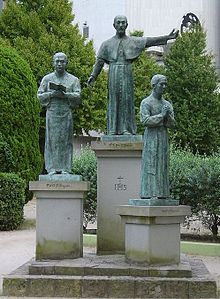 A statue of Francis Xavier (middle) with his disciples Yajiro (left) and Bernardo (right), in Xavier Park (Kagoshima city, Japan).
A statue of Francis Xavier (middle) with his disciples Yajiro (left) and Bernardo (right), in Xavier Park (Kagoshima city, Japan).
Japan was forced to open to foreign interaction by Matthew Perry in 1853. It became possible to live in Japan for foreigners with the Harris Treaty in 1858. Many Christian clergymen were sent from Catholic, Protestant and Orthodox Churches, though proselytizing was still banned. In 1865, some of the Japanese who lived in Urakami village near Nagasaki visited the new Ōura Church which had been built by the Paris Foreign Missions Society (Missions étrangères de Paris) barely a month before. A female member of the group spoke to a French priest, Bernard Thadee Petitjean, and confessed that their families had kept the Kirishitan faith. Those Kirishitan wanted to see the statue of St. Mary with their own eyes, and to confirm that the priest was single and truly came from the pope in Rome. After this interview, many Kirishitan thronged toward Petitjean. He investigated their underground organizations and discovered that they had kept the rite of baptism and the liturgical years without European priests for nearly 250 years. Petitjean’s report surprised the Christian world; Pope Pius IX called it a miracle.
The Edo Shogunate's edicts banning Christianity were still on the books, however, and thus the religion continued to be persecuted up to 1867, the last year of its rule. Robert Bruce Van Valkenburgh, the American minister-resident in Japan, privately complained of this persecution to the Nagasaki magistrates, though little action was taken to stop it. The succeeding Meiji government initially continued in this vein and several thousand people were exiled (Urakami Yoban Kuzure). After Europe and the U.S. began to vocally criticize the persecution, the Japanese government realized that it needed to lift the ban in order to attain its interests. In 1873 the ban was lifted. Numerous exiles returned and began construction of the Urakami Cathedral, which was completed in 1895.
It was later revealed that tens of thousands of Kirishitan still survived in some regions near Nagasaki. Some officially returned to the Roman Catholic Church. Others remained apart from the Catholic Church and have stayed as Kakure Kirishitan, retaining their own traditional beliefs and their descendants asserting that they keep their ancestors' religion.[30] However, it became difficult for them to keep their community and rituals, so they have converted to Buddhism or Shinto eventually.[31] When John Paul II visited Nagasaki in 1981, he baptized some young people from Kakure Kirishitan families, a rare occurrence.[32]
Kirishitan Daimyo
- Omura Sumitada, first Christian feudal lord (1533–1587)
- Omura Yoshiaki
- Arima Harunobu, Christian name Dom Protasio, Lord of Shimabara (1567–1612)
- Arima Naozumi
- Kuroda Yoshitaka, Dom Simeao, a chief strategist of Hideyoshi's.
- Yukinaga Konishi, Dom Agostinho, chief member of Hideyoshi's field staff (1556–1600)
- Dom Justo Takayama Ukon daimyo of Akashi
- Gamō Ujisato (1556–1595)
- Ōtomo Sōrin (大友 宗麟) (1530–1587), also known as Fujiwara no Yoshishige (藤原 義鎮) and Ōtomo Yoshishige (大友 義鎮). Christian name Dom Francisco; referred to as the "King of Bungo" by the Jesuits.
- Ōtomo Yoshimune (大友 義統), Constantino
- Ōtomo Chikaie (大友 親家), Dom Sebastin
- Ōtomo Chikamori (大友 親盛)
- Oda Hidenobu, Christian name Peter
- Tsugaru Nobuhira
Notable Kirishitans
- Twenty-six Martyrs of Japan
- Paulo Miki (1563–1596)
- Amano Motonobu (天野元信)
- Petro Kassui Kibe (1587–1639)
- Mancio Ito (伊東マンショ Itō Mansho), 伊東祐益 1570–1612
- Julião Nakaura (中浦ジュリアン Nakaura Jurian)
- Martinão Hara (原マルチノ Hara Maruchino)
- Miguel Chijiwa (千々石ミゲル Chijiwa Migeru)
- Akashi Takenori
- Hasekura Tsunenaga (支倉常長)
- Naitō Yukiyasu
- Bizen no Gomoji, Hideyoshi daughter (1574–1634)
- Hosokawa Gracia
- Amakusa Shirō
In popular culture
- Shusaku Endo's novel Silence deals with the 17th century suppression of the last known Japanese Christian communities.
See also
- Kakure Kirishitan ("hidden Christian") refers to the Japanese communities that continued to secretly practice a native form of Christianity in spite of persecution. Their isolation led to their drifting away from the foreign version of the religion.
- Roman Catholicism in Japan
- Martyrs of Japan
- Nanban trade period
- Nippo jisho
- Japanese words of Portuguese origin
- Suwa Shrine (Nagasaki)
Citations
- ^ a b c Jansen, page 67
- ^ Documentos de Japon
- ^ Cultural Interactions
- ^ Catholic Encyclopedia, Xavier entry
- ^ Catholic Forum
- ^ Jansen, page 77
- ^ a b c Jansen, p. 22
- ^ St Francis Xavier and the Shimazu Family
- ^ L. Walker, 2002 - Foreign Affairs and Frontiers
- ^ Hōryū-ji, Kondō
- ^ Hōryū-ji, Gojyūnotō
- ^ Cooper, page 160: I have received information that in your kingdoms the promulgation of the law, i.e. Christianity, is a trick and deceit by which you overcome other kingdoms, he wrote in a letter to the Philippines in reply to the embassy led by Navarrete Fajardo in 1597. Christian missionaries, in Hideyoshi's mind, represented the first wave of European imperialism.
- ^ Toshihiko
- ^ Elison, pages 54 and 64
- ^ Nosco, 1993
- ^ Jansen, pages 67-68
- ^ Jansen, page 68
- ^ Jansen, 68
- ^ a b Costa, 2003 - Misericordias
- ^ [#Jansen|Jansen], p. 29
- ^ Kiernan
- ^ [#Jansen|Jansen], pp. 5, 29
- ^ Higashibaba, page 139: The Kirishitan band happened to reach Japan. Not only have they sent merchant vessels to exchange commodities, but they also spread a pernicious doctrine to confuse the right ones, so thay they would change the government of the country and own the country. This will become a great catastrophe. We cannot but stop it.
- ^ Shimizu, pages 284–286
- ^ Jansen, page 57
- ^ Mullins, 1990
- ^ Jansen, page 58]]
- ^ Catholic Encyclopedia, Japan entry
- ^ Keikyo
- ^ Miyazaki, pp. 282-3
- ^ Miyazaki, pp.284-286
- ^ Miyazaki, p.287
Bibliography
References
- Father Juan Garcia Ruiz-de-Medina. Documentos del Japón (1990, 1995 ed.). Rome.
- Father Juan Garcia Ruiz-de-Medina (1993). Cultural Interactions in the Orient 30 years before Matteo Ricci. Catholic Uni. of Portugal.
 "St. Francis Xavier". Catholic Encyclopedia. New York: Robert Appleton Company. 1913.
"St. Francis Xavier". Catholic Encyclopedia. New York: Robert Appleton Company. 1913.- "Saint Francis Xavier on Catholic Forum". http://www.catholic-forum.com/saints/saintf08.htm.
- Marius Jansen (2000). The Making of Modern Japan. Harvard University Press.
- Lopez-Gay (2003). "St Francis Xavier and the Shimazu Family". Bulletin of Portuguese/Japanese Studies (Uni. Nova de Lisboa, Portugal).
- Costa, João Paulo Oliveira (2003). "The misericordias among Japanese Christian communities in the 16th and 17th centuries". Bulletin of Portuguese/Japanese Studies 5: 67–79.
- Kiernan, Ben (2007). Blood and Soil. Yale Univ Press. pp. 125–6. ISBN 0-30010-098-1.
- Higashibaba, Ikuo (2001). Christianity in Early Modern Japan: Kirishitan Belief and Practice. Brill Academic Publishers, Incorporated. ISBN 9-00412-290-7.
- Shimizu, Hirokazu (1977). Kirishitan Kankei Hosei Shiryo Shu.
- L. Walker, Brett (Fall 2002). "Foreign Affairs and Frontiers in Early Modern Japan: a Historio-graphical Essay". Early Modern Japan: an Interdisciplinary Journal 10 (2): 44–62.
- "Kondō" (in Japanese). Hōryū-ji. http://www.horyuji.or.jp/kondo.htm. Retrieved 2009-11-23.
- "五重塔" (in Japanese). Hōryū-ji. http://www.horyuji.or.jp/gojyunoto.htm. Retrieved 2009-11-23.
- Cooper, Michael (1974). Rodrigues the Interpreter= An Early Jesuit in Japan and China. Weatherhill, New York. ISBN 0-83480-319-4.
- Elison, George (1973). Deus Destroyed; The Image of Christianity in Early Modern Japan. Harvard University Press. ISBN 0-67419-962-6.
- Nosco, Peter (1993). "Secrecy and the Transmission of Tradition, Issues in the Study of the 'Underground Christians". Japanese Journal of Religious Studies 20 (1): 3–30.
- Toshihiko, Abe (1998). Japan's Hidden Face. Bainbridgebooks/Trans-Atlantic Publications. ISBN 1-8916-960-5X.
- Mullins, Mark R. (1990). "Japanese Pentecostalism and the World of the Dead: a Study of Cultural Adaptation in Iesu no Mitama Kyokai". Japanese Journal of Religious Studies 17 (4): 353–374.
 "Japan". Catholic Encyclopedia. New York: Robert Appleton Company. 1913.
"Japan". Catholic Encyclopedia. New York: Robert Appleton Company. 1913.- "The Keikyo Institute: "Nestorian Christianity in the Tang Dynasty"". http://www.keikyo.com.
- Miyazaki, Kentaro (2001) (in Japanese). Kakure Kirishitan --Orasho, Figured Bass of Their Souls,. Nagasaki Shimbun Shinsho. ISBN 4-931493-40-8.
Further reading
- Hall, John Whitney, Whitney Hall (2007). The Cambridge History of Japan. Cambridge University Press. ISBN 0521657288.
- Turnbull, Stephen (1998). The Kakure Kirishitan of Japan: A Study of Their Development, Beliefs and Rituals to the Present Day. RoutledgeCurzon. ISBN 1873410700.
- Higashibaba, Ikuo (2002). Christianity in Early Modern Japan: Kirishitan Belief and Practice. Brill Academic Publishers. ISBN 9004122907.
- Junji, Kawashima (1998). Kanto heiya no kakure Kirishitan. Sakitama Shuppankai. ISBN 487891341X.
- Elisonas, Jurgis S. A. (2007). "Journey to the West". Japanese Journal of Religious Studies (Nanzan Institute for Religion and Culture) 34 (1): 27–66.
- Kitagawa, Tomoko (2007). "The Conversion of Hideyoshi’s Daughter Gō". Japanese Journal of Religious Studies (Nanzan Institute for Religion and Culture) 34 (1): 9–25.
- Wakakuwa, Midori (2005). Quattro Ragazzi: Tenshō Mission of Youths and the Imperial World. Shūei-sha.
- Cooper, Michael (2005). The Japanese Mission to Europe, 1582–1590; The journey of Four Samurai Boys through Portugal, Spain and Italy. Global Oriental Ltd. ISBN 1-901903-38-9.
- Secretariat, General (2007). "AN OVERVIEW OF THE HISTORY OF THE CATHOLIC CHURCH IN JAPAN, 1543-1944". Catholic Bishops' Conference of Japan. http://www.cbcj.catholic.jp/eng/ehistory/table01.htm. Retrieved 2007-12-22.
- Eishiro, Ito (2007). "Unveiling Histories of the Tohoku District; Juan Goto and Crypto-Christians". IWATE PREFECTURAL UNIVERSITY. http://p-www.iwate-pu.ac.jp/~acro-ito/Japan_pics/Japan_MZS/Juan_Goto.html. Retrieved 2007-12-22.
- Boxer Charles R. & J. S. Cummins, 'The Dominican mission in Japan (1602–1622), 1963
- __________. The Christian Century in Japan. 3rd edition. Manchester: Carcanet, 1993.
- Murai Shōsuke y “Tanegashima: The Arrival of Europe in Japan”. Bulletin of Portuguese/Japanese Studies 8: 93–106 2004.
- Costa, João Paulo Oliveira 'Portugal e o Japão: O século namban', Lisbon: Imprensa Nacional and 'The misericordias among Japanese Christian communities in the 16th and 17th centuries'. Bulletin of Portuguese/Japanese Studies 5: 67–79. 2003 and Tokugawa Ieyasu and the Christian daimyo during the crisis of 1600. Bulletin of Portuguese/Japanese Studies 7: 45–71.
- Elison, George The Image of Christianity in Early Modern Japan. Cambridge Mass.1973 Deus Destroyed: Council of East Asian Studies, Harvard University.
- Fróis, Luís, SJ Historia de Japam. José Wicki, SJ, ed., 5 vols. Lisbon: Biblioteca Nacional 1976–1984.
- Fujita, Neil Japan’s Encounter with Christianity: The Catholic Mission in Pre-modern Japan. New York: Paulist Press 1991.
- Sá, Isabel dos Guimarães Quando o rico se faz pobre: Misericórdias, caridade e poder no império português 1500–1800. Lisbon: Comissão Nacional para as Comemorações dos Descobrimentos Portugueses, 1997 and Francis Xavier, His Times His Life. 4 vols. Rome: Jesuit Historical Institute.
External links
- Pilgrimage Sites and Churches in Nagasaki by TCA (Think Catholic Asia) Japan located inside Nagasaki Catholic Center
- 2008 Beatification of Japanese Martyrs.
Roman Catholicism in Asia Sovereign
states- Afghanistan
- Armenia
- Azerbaijan
- Bahrain
- Bangladesh
- Bhutan
- Brunei
- Burma (Myanmar)
- Cambodia
- People's Republic of China
- Cyprus
- East Timor (Timor-Leste)
- Egypt
- Georgia
- India
- Indonesia
- Iran
- Iraq
- Israel
- Japan
- Jordan
- Kazakhstan
- North Korea
- South Korea
- Kuwait
- Kyrgyzstan
- Laos
- Lebanon
- Malaysia
- Maldives
- Mongolia
- Nepal
- Oman
- Pakistan
- Philippines
- Qatar
- Russia
- Saudi Arabia
- Singapore
- Sri Lanka
- Syria
- Tajikistan
- Thailand
- Turkey
- Turkmenistan
- United Arab Emirates
- Uzbekistan
- Vietnam
- Yemen
States with limited
recognition- Abkhazia
- Nagorno-Karabakh
- Northern Cyprus
- Palestine
- Republic of China (Taiwan)
- South Ossetia
Dependencies and
other territoriesCategories:- Christianity in Japan
- Feudal Japan
- Japanese historical terms
- Roman Catholic Church in Japan
Wikimedia Foundation. 2010.

